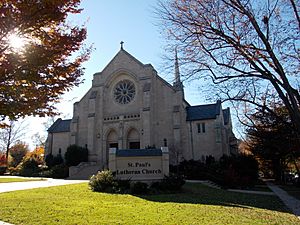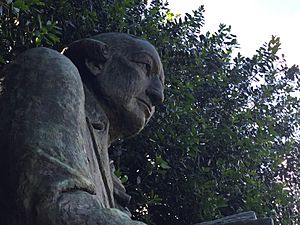Peter Muhlenberg Memorial facts for kids

The memorial in 2019
|
|
| Coordinates | 38°57′13″N 77°04′10″W / 38.95361°N 77.06944°W |
|---|---|
| Location | Muhlenberg Park, Washington, D.C., United States |
| Designer | Caroline Hufford (sculptor) John Harbeson (architect) |
| Material | bronze (sculpture) limestone (base) concrete (exedra) |
| Height | 4 feet (1.2 m) (sculpture) 8.16 feet (2.49 m) (base) 2 feet (0.61 m) (exedra) |
| Opening date | October 26, 1980 |
| Dedicated to | Peter Muhlenberg |
The Peter Muhlenberg Memorial is a special monument in Washington, D.C.. It honors John Peter Gabriel Muhlenberg. He was an important person in early American history. Peter Muhlenberg was a Lutheran minister, a general in the Continental Army during the American Revolution, and a politician.
The memorial is located in a one-acre park. This park is found in the Wakefield neighborhood of Washington, D.C. The park is bordered by Connecticut Avenue, Ellicott Street, and 36th Street NW.
The memorial was designed by architect John Harbeson. At its center is a bronze bust (a sculpture of a person's head and shoulders) of Muhlenberg. This bust was created by Caroline M. Hufford, who was a descendant of Peter Muhlenberg. The memorial was finished in 1980. This was 52 years after the Congress first approved its construction. Important people attended the dedication ceremony, including the West German ambassador.
The bronze sculpture of Muhlenberg stands on a limestone base. It is surrounded on three sides by a concrete exedra (a curved bench or wall). The National Park Service owns and takes care of the memorial. This is a federal agency of the Interior Department.
Contents
History of the Memorial
How the Park Started
In the late 1800s, the area where Muhlenberg Park now stands was a rural part of Washington County, D.C.. It was a crossroads of Grant Road and Chappell Road. In 1871, Washington County, Washington City, and Georgetown joined together. This created the modern boundaries of Washington, D.C..
Over the next few decades, streetcars made it easier for people to settle in the city's far Northwest. In 1907, a bridge was built over the Rock Creek gorge. This allowed Connecticut Avenue to run all the way from downtown to Chevy Chase, Maryland. As the area grew, Grant Road was mostly replaced by a street grid. Only a few parts of it remain today. Chappell Road was connected to 36th Street NW and renamed. This left a small, triangular piece of land between it and Connecticut Avenue.
In 1925, a church called the Evangelical Lutheran Church of the Epiphany bought land at 4900 Connecticut Avenue NW. They planned to move there. The next year, this church merged with St. Paul's English Lutheran Church. They kept the St. Paul's name. St. Paul's Church had grown very large. Their old building could no longer hold all the people.
The church decided to donate the front part of their new property to the federal government. This land was perfect for a memorial. They wanted to honor Peter Muhlenberg, a Lutheran minister, a hero of the American Revolution, and an early American politician.
Planning the Monument
On May 2, 1928, Congress passed a law to allow the monument to be built. Money for the monument was to be raised by the Peter Muhlenberg Memorial Association. The design needed to be approved by the United States Congress Joint Committee on the Library and the United States Commission of Fine Arts.
Congressmen Alfred L. Bulwinkle and R. Walton Moore supported the plan. Bulwinkle called Muhlenberg "one of America's great men." He believed Congress should thank the Memorial Association for wanting to build a monument to someone who helped create the United States.
However, the Great Depression caused financial problems. This delayed the building of the new church and stopped fundraising for the memorial.
In 1959, after the church was finished, a committee started raising money again. Henry F. Lerch III, a lawyer and church member, helped restart the project. He wanted the memorial to be ready for the United States Bicentennial in 1976.
John Harbeson was chosen as the architect. Caroline Muhlenberg Hufford was chosen to sculpt the bust. She was a descendant of Peter Muhlenberg. The E. A. Baker Company was hired to build it. After some changes to the design, the Commission of Fine Arts approved it in 1975. The memorial cost about $59,430 to build.
Dedication Ceremony
The memorial was officially dedicated on October 26, 1980. This day is known as Reformation Sunday. About 300 people attended the ceremony. These included the West German Ambassador to the United States, Peter Hermes. The mayor of Woodstock, Virginia, James Lambert, was also there. Muhlenberg had preached in Woodstock before the American Revolution.
A color guard from Woodstock and about thirty of Muhlenberg's descendants also attended. Dr. Russell Zimmerman gave a speech before the ceremony. He called Muhlenberg "a giant among giants" in America's fight for justice and freedom. Henry Lerch had the honor of unveiling the statue. Robert Stanton of the National Park Service accepted the memorial on behalf of the government.
Later Years
The National Park Service owns and maintains the memorial and the park around it. It is part of the Rock Creek Park area. The park is along the Fort Circle Parks greenway. This greenway is a proposed system of trails. These trails would connect the Fort Circle Parks, like nearby Fort Reno, to other open spaces in Washington, D.C.
Design and Location
The memorial is in the center of Muhlenberg Park. This park is in the northwest quadrant of Washington, D.C. It is a one-acre pocket park. It is located on the land bordered by Connecticut Avenue, Ellicott Street, and 36th Street NW.
The park is right next to St. Paul's Lutheran Church. It is also near Engine Company 31, a fire station. Other nearby places include Politics and Prose bookstore and Comet Ping Pong restaurant.
The bronze bust of Muhlenberg sits on top of a limestone base. The sculpture is about 4 feet tall and 4 feet wide. It shows Muhlenberg in regular clothes. His hands are resting on an open Bible in front of him.
The base is about 8 feet tall. It looks like a pulpit, which is a raised stand where a preacher speaks. On three sides of the base, there are carvings. These carvings show Muhlenberg's important roles in his country: Clergyman, Soldier, and Statesman.
- The Clergyman side has a Latin cross and the years "1768–1776."
- The Soldier side has a saber (a type of sword) and the years "1774–1783."
- The Statesman side has a fasces (a symbol of authority) and the years "1787–1807."
The front of the base has an inscription that reads: "JOHN PETER GABRIEL MUHLENBERG, 1746–1807; Serving HIS CHURCH, HIS COUNTRY, HIS STATE." A rectangular concrete exedra with three plaques is behind and on the sides of the memorial. These plaques provide information about Muhlenberg's life.
The original plan for the memorial included two fountains and a pond. These were meant to be added later. However, these plans were never completed.
Images for kids
See also
 In Spanish: Monumento conmemorativo a Peter Muhlenberg para niños
In Spanish: Monumento conmemorativo a Peter Muhlenberg para niños








